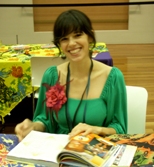
Katherine Gressel
Talking Points: Public Art and the Challenge of Evaluation
Posted by May 17, 2012

Katherine Gressel
The Challenge of Evaluation
In the Fall/Winter 2011 issue of Public Art Review, Jack Becker writes, “There is a dearth of research efforts focusing on public art and its impact. The evidence is mostly anecdotal. Some attempts have focused specifically on economic impact, but this doesn’t tell the whole story, or even the most important stories.”
Becker’s statement gets at some of the main challenges in measuring the impact of a work of public art—a task which more often than not provokes grumbling from public art administrators. Unlike museums or performance spaces, public art traditionally doesn’t sell tickets, or attract “audiences” who can easily be counted, surveyed, or educated.
A public artwork’s role in economic revitalization is difficult to separate from that of its overall surroundings. And as Becker suggests, economic indicators of success may leave out important factors like the intrinsic benefits of experiencing art in one’s everyday life.
However, public art administrators generally agree that some type of evaluation is key in not only making a case for support from funders, but in building a successful program.
Is there a reliable framework that can be the basis of all good public art evaluation? And what are some simple yet effective evaluation methods that most organizations can implement?
Read More







